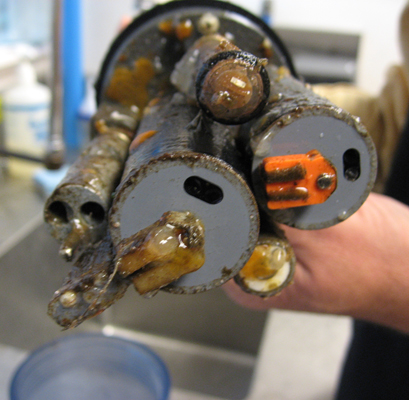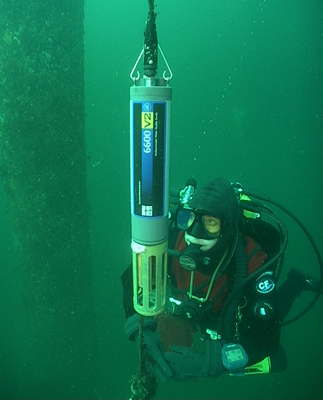
Mooring Specifications
Sondes and Sensor Arrays
 YSI 6600 V2 sonde
YSI 6600 V2 sonde
 Sea-Bird HC-EP instrument
Sea-Bird HC-EP instrument
King County employs Sea-Bird HydroCAT-EP (HC-EP) instruments for data collection at all marine mooring sites. Prior to 2017, YSI 6600 V2 multi-parameter data sondes were used.
Both of these sensors measure water temperature, conductivity (salinity), pressure (depth), dissolved oxygen, turbidity (at some sites), pH (at some sites), and fluorescence (chlorophyll).
The YSI 6600 V2 datasonde consists of a cylindrical, pressure-resistant body with a cable connection at one end and an array of external sensors on the opposite end. The Sea-Bird HC-EP has an internal flow path with an integral pump for some of the sensors, as well as an external optical sensor with a copper faceplate for chlorophyll and turbidity. Both types are configured to receive external power and communicate via SDI-12 to a datalogger.
In addition to the datasondes deployed at each site, several other sensors are deployed at specific sites (see Deployments). Additional sensors included:
- Satlantic SUNA (Submersible Ultraviolet Nitrate Analyzer) Sensor - the SUNA is a real-time, chemical-free optical sensor that calculates nitrite + nitrate concentrations based on ultraviolet absorption and from a calibration curve derived from water samples.
- Satlantic SeaFET Sensor – the SeaFET is a high-precision pH sensor that can be more stable over time compared to the glass electrode sonde pH on the datasondes. It measures pH in total scale using an ion sensitive field effect transistor (ISFET). The interface with the seawater environment contains pH sensitive material, and the potential of the ISFET is measured against a reference to calculate pH. The SeaFET has two separate references: the internal and external reference electrodes. Typically, the external reference is used for the final pH data, after correction by salinity and validation water samples.
- Vaisala WXT510 meteorological station – the “met” stations record air temperature, relative humidity, wind speed and direction, rainfall, and photosynthetically active radiation (via Apogee Quantum Sensor). For wind data collection, fixed mooring sites (such as at a pier) use the Vaisala ultrasonic wind meter, while moving platforms such as the buoy use a mechanical wind sensor (RM Young wind monitor HD).
The following table provides specifications for each of the sensors:
Sensor Specifications
| Sensor | Range | Resolution | Accuracy |
| YSI Depth (m) | 0 to 61 | 0.001 | ± 0.12 |
| HC-EP Depth (m) | 0 to 100 | 0.002 | ± 0.1 |
| YSI Temperature (°C) | -5 to 50 | 0.01 | ± 0.15 |
| HC-EP Temperature (°C) | -5 to 45 | 0.0001 | ± 0.002 |
| YSI Conductivity (mS/cm) | 0 to 100 | 0.001 to 0.1 | ± 0.5% of reading |
| HC-EP Conductivity (mS/cm) | 0 to 70 | 0.001 | 0.003 |
| YSI Salinity (psu) | 0 to 42 | 0.01 | 0.1 psu or 1%, whichever is greater |
| HC-EP Salinity (psu) | 0 to 42 | 0.001 | 0.005 psu |
| YSI Dissolved Oxygen (mg/L) | 0 to 50 | 0.01 | ± 0.1 mg/L or 1%, whichever is greater |
| HC-EP Dissolved Oxygen (mg/L) | 0 to 25 | 0.007 | ± 0.1 mg/L or 2%, whichever is greater |
| YSI Turbidity (NTU) | 0 to 1,000 | 0.1 | 0.3 NTU or 2%, whichever is greater |
| HC-EP Turbidity (NTU) | 0 to 3,000 | 0.06 - 0.17 | ±1% |
| Sonde pH (YSI) | 0 to 14 | 0.01 | ± 0.2 |
| Sonde pH (HC-EP) | 0 to 14 | 0.01 | ± 0.1 |
| YSI Chlorophyll (µg/L) | 0 to 400 | 0.1 | ~0.1 µg/L detection limit |
| HC-EP Chlorophyll (µg/L) | 0 to 400 | 0.007 -0.037 | ±3% |
| pH (SeaFET, recalculated, total scale) | 6.5 to 9.0 | 0.004 | ± 0.02 |
| pH initial (not recalculated) | 6.5 to 9.0 | 0.0001 | Requires validation |
| Nitrite+Nitrate-Nitrogen (mg/L) | 0.007 to 56 | 0.01 | ± 0.028 or 10% |
| Wind Direction (degrees) | 0 to 360 | 1 | ± 3° |
| Vaisala Wind Speed (m/sec) | 0 to 60 | 0.1 | ± 0.3 or ± 3% |
| RM Young HD Wind Speed (m/sec) | 0 to 100 | 0.1 | ± 0.3 or ± 1% |
| Air Temperature (°F) | -60 to 140 | 0.1 | ± 0.3 |
| Pressure (in Hg) | 17.7 to 32.5 | 0.01 | ± 0.015 |
| Relative Humidity (%) | 0 to 100 | 0.1 | ± 5% |
| Rain Fall (in) | NA | 0.001 | ± 5% |
| Photosynthetically Active Radiation (µmol/s/sq meter) | NA | 1 | ± 5% |
The sensors at each mooring are connected to WaterLOG Storm 3 data-logger, which is configured to collect measurements every 15 minutes. These data-logger and telemetry units collect and transmit real-time data via cellular modem to the marine moorings database.
Deployments
The four marine mooring systems that King County currently deploys are located in Elliott Bay at the Seattle Aquarium, in the Central Basin of Puget Sound off of Point Williams, in outer Quartermaster Harbor at Dockton Park, and in inner Quartermaster Harbor at the Quartermaster Harbor Yacht Club.
 Seattle Aquarium mooring at 10-m (Photo courtesy of Shawn Larson)
Seattle Aquarium mooring at 10-m (Photo courtesy of Shawn Larson)
 Point Williams buoy (photo by S. Jaeger)
Point Williams buoy (photo by S. Jaeger)
Seattle Aquarium (Elliott Bay)
- 2x Sea-Bird HydroCat-EP datasondes
The Elliott Bay mooring system is located at, and is a joint project with, the Seattle Aquarium. The mooring system is comprised of two sonde/sensor arrays that are deployed from the Aquarium’s pump house at the end of Pier 59. A weighted-pulley system allows the two data sondes to be deployed at fixed depths – approximately one meter and ten meters below the surface. Prior to March 14, 2019, the meteorological system was located on the roof of the pump house. Prior to September 27, 2017, two YSI 6600 V2 sondes were deployed at this site.
Dockton Park (Outer Quartermaster Harbor)
- Sea-Bird HydroCat-EP datasonde
- Meteorological station
The outer Quartermaster Harbor mooring system is located in Dockton Park. It’s deployed as a fixed, piling-mounted system, one meter above the bottom on the outermost pier at the Dockton Park marina. As a fixed system, the total water depth, at any given time, fluctuates with the tidal cycle. The sonde is deployed at depths that generally range between 4.5 and 8.5 meters below the surface. The meteorological system is located at the top of one of the pier’s pilings. Prior to December 13, 2017, a YSI 6600 V2 sonde was deployed at this site.
Quartermaster Yacht Club (Inner Quartermaster Harbor)
- Sea-Bird HydroCAT-EP datasonde
- SeaFET pH sensor
The inner Quartermaster Harbor mooring system is located at the Quartermaster Yacht Club. The system is located on a floating dock and collects data at a fixed depth of approximately 1 m below the surface. The HC-EP datasonde is deployed alongside a SeaFET pH sensor. Prior to February 2, 2017, a YSI 6600 V2 datasonde was deployed at this site.
Point Williams Buoy (Central Puget Sound)
- Sea-Bird HydroCAT-EP datasonde
- SeaFET pH sensor
- SUNA nitrate sensor
- Meteorological station
The mooring system located in Central Puget Sound off of Point Williams is deployed from an oceanic buoy. The mooring system, which includes a HC-EPdatasonde, SeaFET sensor, and SUNA sensor, is deployed 1 meter below the surface. Beginning in March 14, 2019, a Vaisala meteorological system was installed on the buoy, with a RM Young wind monitor HD for wind direction and speed. Prior to February 15, 2017, a YSI 6600 V2 datasonde was deployed at this site.